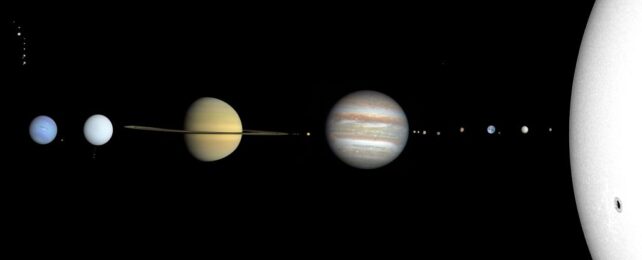The void of space is supposed to be silent. There, where atoms are spaced too far apart to allow the propagation of sound waves, any scream gets snuffed out before it can begin.
But that doesn't mean no sound can be derived. In fact, if we could only hear them, some of the bodies of the Solar System would emit a deafening clamor.
Others, we wouldn't be able to hear… but, we could convert the plasma waves rippling around them. Plasma waves are formed as electrons become trapped in magnetic field lines around large objects such as planets and spiral down them.
If we convert the frequencies of the plasma waves into sound, we can hear their eerie shrieks and cries.
Each Solar System body has its own sounds. The Sun, for instance, should be positively roaring as its surface roils with constantly rising and sinking convection cells larger than the state of Texas.
Scientists have estimated that, if sound could propagate through space, we could hear the Sun as a constant roar hammering at an ear-bursting 100 decibels.
The very first sounds from space were recorded by astronomer Karl Guthe Jansky in 1932.
He'd built a rotating radio telescope that was nicknamed Jansky's Merry-Go-Round, designed to detect a specific frequency range of radio waves. When his data started coming in, there was a persistent background hiss that, Jansky discovered, was not random noise, but the sound of the heart of the Milky Way galaxy itself.
When we started sending probes into space with the launch of Sputnik in 1957, we started getting more data, picked up by instruments aboard those probes.
Those include instruments designed to pick up invisible forms of light, as well as waves in the plasma in the sometimes chaotic environments around the planets of the Solar System.
Radio waves aren't sound; they're a form of light in which sound data can be encoded, and when picked up by a receiver, converted back into sound. Mobile phones work similarly. The technology for converting electromagnetic waves into sound is very well established.
In fact, we've even heard radio waves in space that scientists have translated into spoken words. It was radio waves from Earth that leaked into space, but that does demonstrate that the data these instruments pick up is accurate.
Plasma waves that swirl around planets can also generate interesting chirps and whistles known as a chorus.
Earth's can sound a bit like birds, or whales. Saturn, with its complex system of moons and rings, sounds like a soundtrack from an eerie 1950s sci-fi movie.
Even Jupiter's moons have complex sound profiles of their own. Europa and Ganymede have both been recorded emitting plasma sounds that resemble robotic blips and bleeps. And Jupiter's powerful ultraviolet aurorae are absolutely breathtaking.
Mars doesn't have much of a magnetic field to speak of, but we do know what its winds sound like. Both the InSight lander and the Perseverance rover have recorded the haunting, lonely sounds of the Martian winds, as dust devils dance across the dusty surface.
It's not just the Solar System, either. Space is immense, and strange, and converting light into sounds can help scientists uncover hidden details they may have missed. So, if you want to feel truly small, you can listen to the sound of a supermassive black hole, humming in space 250 million light-years away.
NASA has compiled a bunch of its sonifications into a playlist that you can listen to over on the NASA Science website. You can also find a bunch more at Space Audio, a YouTube channel run by a sole volunteer from the University of Iowa. If you want a truly eerie soundtrack for a party, your daily run, or just a nice relaxing hot bath, these resources have got you covered.
